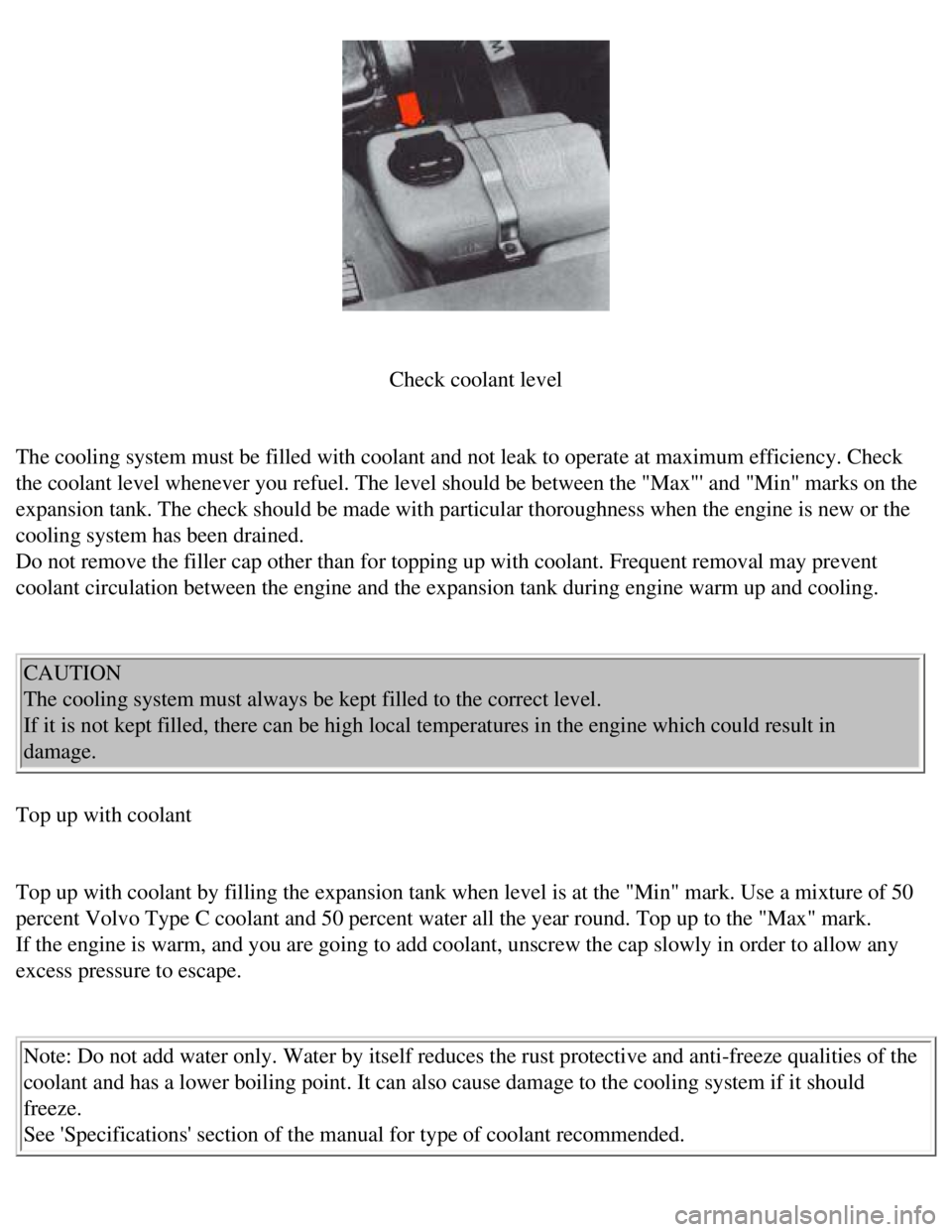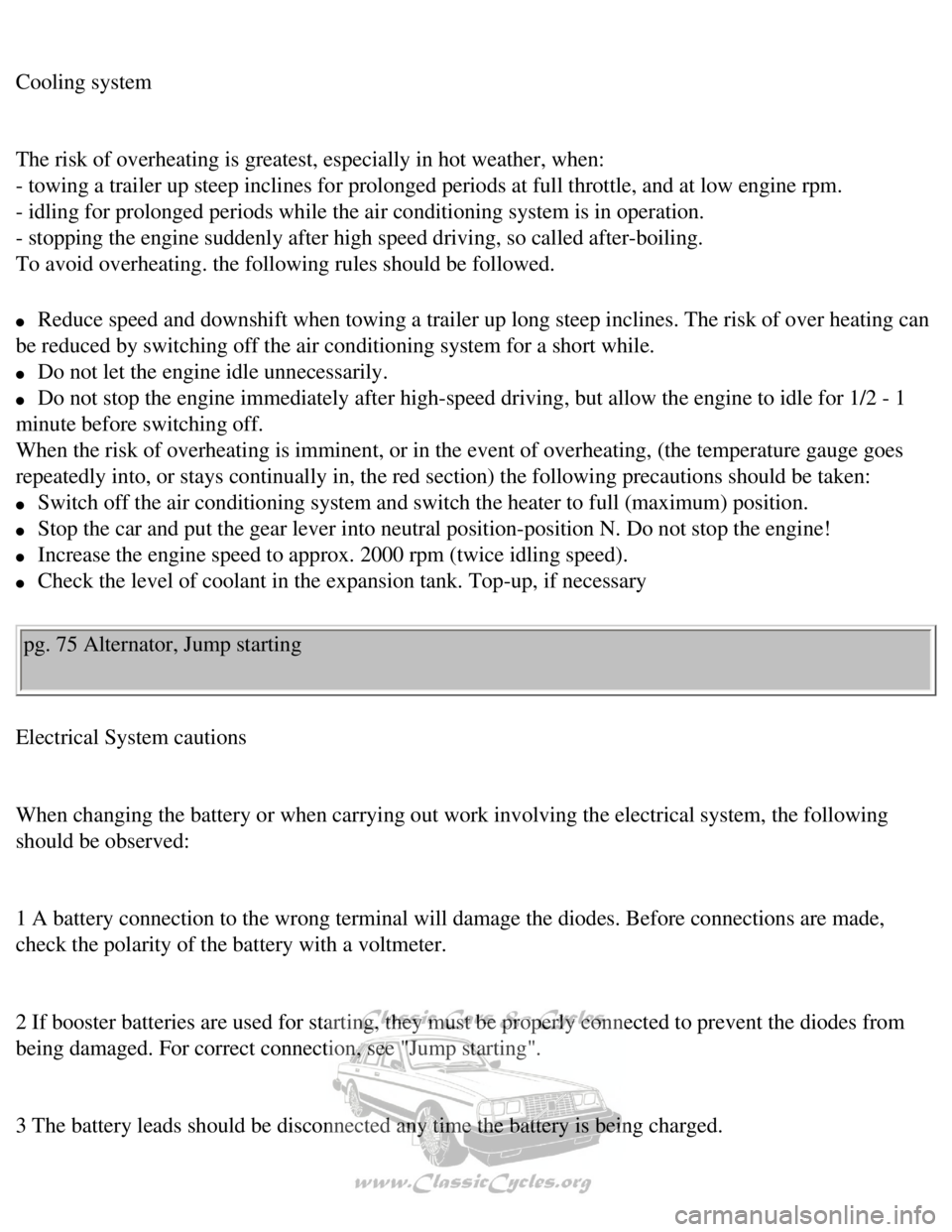Page 99 of 143

Volvo 1990 240 Model
Check coolant level
The cooling system must be filled with coolant and not leak to operate a\
t maximum efficiency. Check
the coolant level whenever you refuel. The level should be between the "\
Max"' and "Min" marks on the
expansion tank. The check should be made with particular thoroughness wh\
en the engine is new or the
cooling system has been drained.
Do not remove the filler cap other than for topping up with coolant. Fre\
quent removal may prevent
coolant circulation between the engine and the expansion tank during eng\
ine warm up and cooling.
CAUTION
The cooling system must always be kept filled to the correct level.
If it is not kept filled, there can be high local temperatures in the en\
gine which could result in
damage.
Top up with coolant
Top up with coolant by filling the expansion tank when level is at the "\
Min" mark. Use a mixture of 50
percent Volvo Type C coolant and 50 percent water all the year round. To\
p up to the "Max" mark.
If the engine is warm, and you are going to add coolant, unscrew the cap\
slowly in order to allow any
excess pressure to escape.
Note: Do not add water only. Water by itself reduces the rust protective\
and anti-freeze qualities of the
coolant and has a lower boiling point. It can also cause damage to the c\
ooling system if it should
freeze.
See 'Specifications' section of the manual for type of coolant recommend\
ed.
file:///K|/ownersdocs/1990/1990_240/90240_15.htm (7 of 10)12/30/2006 8\
:25:09 AM
Page 100 of 143

Volvo 1990 240 Model
Cooling system
The risk of overheating is greatest, especially in hot weather, when:
- towing a trailer up steep inclines for prolonged periods at full throt\
tle, and at low engine rpm.
- idling for prolonged periods while the air conditioning system is in o\
peration.
- stopping the engine suddenly after high speed driving, so called after\
-boiling.
To avoid overheating. the following rules should be followed.
l Reduce speed and downshift when towing a trailer up long steep inclines.\
The risk of over heating can
be reduced by switching off the air conditioning system for a short whil\
e.
l Do not let the engine idle unnecessarily.
l Do not stop the engine immediately after high-speed driving, but allow t\
he engine to idle for 1/2 - 1
minute before switching off.
When the risk of overheating is imminent, or in the event of overheating\
, (the temperature gauge goes
repeatedly into, or stays continually in, the red section) the followin\
g precautions should be taken:
l Switch off the air conditioning system and switch the heater to full (m\
aximum) position.
l Stop the car and put the gear lever into neutral position-position N. Do\
not stop the engine!
l Increase the engine speed to approx. 2000 rpm (twice idling speed).
l Check the level of coolant in the expansion tank. Top-up, if necessary
pg. 75 Alternator, Jump starting
Electrical System cautions
When changing the battery or when carrying out work involving the electr\
ical system, the following
should be observed:
1 A battery connection to the wrong terminal will damage the diodes. Bef\
ore connections are made,
check the polarity of the battery with a voltmeter.
2 If booster batteries are used for starting, they must be properly conn\
ected to prevent the diodes from
being damaged. For correct connection, see "Jump starting".
3 The battery leads should be disconnected any time the battery is being\
charged.
file:///K|/ownersdocs/1990/1990_240/90240_15.htm (8 of 10)12/30/2006 8\
:25:09 AM
Page 123 of 143

Volvo 1990 240 Model
pg. 91 Long distance trips, Cold weather
Prior to a long distance trip
Have your car checked at a Volvo dealer. Preventive maintenance will hel\
p to ensure a trouble free trip.
Remember to take along a Volvo dealer directory.
The main items to check are listed below:
1. Brakes, front wheel alignment and steering gear.
2. Engine running condition.
3. Fuel system operation.
4. Oil leaks: engine, transmission, rear axle.
5. Cooling system for leaks or worn hoses.
6. Examine tires carefully, replace worn tires.
7. Battery and terminals.
8. Tool equipment.
9. Lighting.
10. Drive belts, for tightness and wear.
11. All fluid levels.
Cold weather/Engine fuel system
During the winter, large variations in temperature cause condensation to\
form in the fuel tank and can
impair the running of the engine. This can be reduced by adding dry gas \
to the fuel. There is less risk of
condensation forming in the fuel tank if it is kept full or nearly full.\
Engine cooling system
Volvo type C (blue-green) coolant should be used all year round. The c\
ooling system should always
contain water plus anti-freeze and rust inhibitor, even during the summe\
r. Experience has also shown
that extremely weak anti-freeze solutions (10-25 percent) are ineffect\
ive for rust protection. For this
reason, the quantity of antifreeze/summer coolant should be about 50 per\
cent of the solution. This
lowers the freezing point to - 30 ° F (-35 ° C).
Engine lubricating system
file:///K|/ownersdocs/1990/1990_240/90240_19.htm (1 of 7)12/30/2006 8:\
25:13 AM
Page 134 of 143
Volvo 1990 240 Model
Type Positive pressure, closed system
Thermostat begins to open at 188.6 ° F
Fan belts, designation HC-38 x 918 (two)
Coolant: Volvo Coolant type C (blue-green)
Fuel system
The engine is equipped with an electronic fuel injection system.
Ignition System
Firing order 1-3-4-2
Ignition setting (12 ° B.T.D.C. at 750 rpm)
Spark plugs Bosch WR7DC (or equivalent)
Spark plug gap 0.028-0.032" (0.7-0.8 mm)
Tightening torque 15-22 ft. lbs. (20-30 Nm)
Distributor, direction of rotation Clockwise pg. 101 Specifications
POWER TRANSMISSION
Manual or automatic transmission. Hypoid type final drive.
Manual transmission M47 II
Reduction ratios:
1st gear 4.03:1
2nd gear 2.16:1
3rd gear 1.37:1 Rear axle reduction ratio:
4th gear 1.00:1 3.31:1
5th gear 0.82:1
Reverse 3.68:1
file:///K|/ownersdocs/1990/1990_240/90240_20.htm (5 of 14)12/30/2006 8\
:25:15 AM
Page 135 of 143
Volvo 1990 240 Model
Automatic transmission AW70
Reduction ratios:
1st gear 2.45:1
2nd gear 2.45:1 Rear axle reduction ratio:
3rd gear 2.45:1 3.73:1
Overdrive 0.69:1
Reverse 2.22:1
Vehicle speed/1000 engine rpm (manual transmission)
Rear axle ratio 3.31:1
mph km/h
1st gear 5.4 8.7
2nd gear 10.0 16.2
3rd gear 15.8 25.5
4th gear 21.7 34.9
5th gear 26.4 42.5
Reverse 5.9 9.5
Front suspension
McPherson type spring and strut suspension. Shock absorbers housed in st\
rut casing. Rack and pinion
steering.
Safety-type steering column.
The alignment specifications apply to an unloaded car but include fuel, \
coolant and spare wheel.
Toe-in, measured on the wheel rim: 1/16" ± 3/64" (1.5 ± 1.0 mm) \
Camber (not to exceed 1/2 ° difference between sides):
- All +1/4° to + 3/4°
(Reduce camber if excessive wear on tire outer shoulder is observed) \
Caster: not adjustable pg. 102 Specifications
file:///K|/ownersdocs/1990/1990_240/90240_20.htm (6 of 14)12/30/2006 8\
:25:15 AM
Page 142 of 143
Volvo 1990 240 Model
Oil level between dipstick marks. The distance between the marks represe\
nts approx. 1 US qt. = 1 liter.
Fill with multigrade oil
Check without removing the cap that the brake fluid level is above the M\
in-mark. Brake and clutch fluid
DOT 4.
Coolant level between the expansion tank marks. Mixture: 50 percent anti\
-freeze and 50 percent water.
Washer fluid reservoir should be filled with water and solvent (wintert\
ime: windshield washer anti-
freeze).
Electrolyte level 1/4" - 3/8" (5 - 10 mm) above plates. Fill distilled\
water only, never acid. Check level
in conjunction with normal service or once a year.
Never operate engine in closed unventilated areas.
Changing a wheel, see pages 84, 85
a bulb, see pages 76-80
a fuse, see page 81
Fuel: Octane rating 95 RON Unleaded, 91 (R+M)/2
Min. 91 RON Unleaded, 87 (R+M)/2 Inside back cover
file:///K|/ownersdocs/1990/1990_240/90240_20.htm (13 of 14)12/30/2006 \
8:25:15 AM